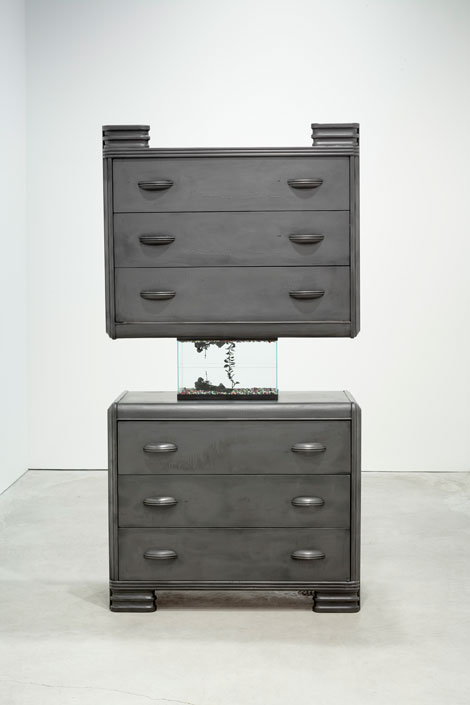Witnessing natural disasters, such as Hurricane Katrina, motivated Kevin Yates’ earlier works that employ motifs of reflection and twinning. Doubling continues with uncanny effect in new representations of decaying decorative/architectural elements, inspired by Edgar Allan Poe’s use of the doppelgänger in his gothic tale “The Fall of the House of Usher.” In the story, the narrator visits a childhood friend and his twin sister, who have both become physically ill due to some mysterious effect of their insidious and dilapidated family estate. The sister, believed dead, is entombed within the house only to emerge days later, a bloody, ghostly figure, who frightens her brother to death as she finally dies at his side. As the narrator escapes the edifice, it sinks into the tarn, consumed by its own reflection.
Upon entering the gallery, one hears a soundtrack of cheerfully twittering birds, which seems at odds with the gravitas of the sculpture at the far end. Against a white backdrop, a dresser, an innocuous domestic object, becomes imposing and disorienting when it is doubled and stacked end-to-end, linked by a memento mori: an aquarium displaying a reclining skeleton. Yates’ entire exhibition “Usher the Fall of the House” (all works 2013), becomes a memorializing work for an imagined context and unknown user, while also functioning to remind viewers of their own mortality.
Yates’ projection Bird Wallpaper (Torn), made with his brother Robert Yates, an experimental filmmaker, simulates shabby and tattered wallpaper. The cheerful chirping suddenly makes sense as small black birds emerge from the foliage patterns. These twittering creatures simultaneously bring life to the damaged décor while also emphasizing disrepair as though the setting has been taken over by nature.
In a distinct space in the gallery, three sculptures of doubled houses, and a video work again created by the two Yates brothers in collaboration, initially seem disparate from the dresser and wallpaper. These pieces move away from the realm of fiction, but continue themes of doubling and disrepair. Unlike the life-size dresser and wallpaper, the sculptures are diminutive and build on the Hurricane Katrina work. Previously, pieces depicted homes shortly after the disaster, whereas these are inspired by a recent trip to New Orleans during which Yates saw damaged dwellings that have remained untouched.
The video Waterline shows a photograph of the kitchen of a home that was abandoned after Katrina. The image’s inversed duplicate moves across it vertically, creating the impression of a reflection in rising/receding water. The gentle ebb and flow is accompanied by a soundtrack of waves and soft saxophone music evocative of a livelier scene than this forgotten kitchen. Most sobering is the glass door at the back of the room in the video. Easily missed, a “0” signifies that no dead were found in the house after the 2005 hurricane.
Yates’ repetition of the seemingly forgotten emphasizes absence, but also invokes a subtle despair in his audience confronted with the disorienting doubling of the dilapidated.


